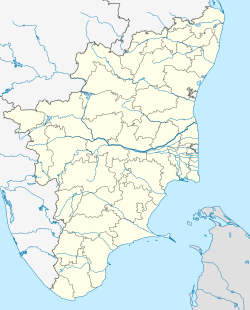Ayothiapattinam
Ayodhyapattinam | |
|---|---|
| Coordinates: 11°28′25″N 77°23′19″E / 11.47361°N 77.38861°E | |
| Country | India |
| State | Tamil Nadu |
| District | Salem |
| Area | |
• Total | 9.6 km2 (3.7 sq mi) |
| Population (2011) | |
• Total | 11,517 |
| • Density | 1,200/km2 (3,100/sq mi) |
| Languages | |
| • Official | Tamil |
| Time zone | UTC+5:30 (IST) |
Ayodhyapattinam is a panchayat town in Vazhapadi taluk of Salem district in the Indian state of Tamil Nadu. It is one of the 31 panchayat towns in the district. Spread across an area of 9.6 km2 (3.7 sq mi), it had a population of 11,517 individuals as per the 2011 census. The panchayat was named after the city of Ayodhya.
Etymology
[edit]The panchayat was named after the city of Ayodhya.[1] The word "Ayodhya" is a regularly formed derivation of the Sanskrit verb yudh, "to fight, to wage war".[2][3] This meaning is attested by the Atharvaveda, which uses it to refer to the unconquerable city of gods.[4]
Geography and administration
[edit]Ayodhyapattinam is located in Vazhapadi taluk of Salem district in the Indian state of Tamil Nadu.[5] Spread across an area of 9.6 km2 (3.7 sq mi),[6] it is one of the of the 31 panchayat towns in the district.[7] The town panchayat is headed by a chairperson, who is elected by the members, who are chosen through direct elections.[8] The town forms part of the Yercaud Assembly constituency that elects its member to the Tamil Nadu legislative assembly and the Salem Lok Sabha constituency that elects its member to the Parliament of India.[9][10]
Demographics
[edit]As per the 2011 census, Ayodhyapattinam had a population of 11,541 individuals across 2,982 households.[11] The population saw a marginal increase compared to the previous census in 2001 when 9,941 inhabitants were registered. The population consisted of 5,726 males and 5,791 females.[6][12] About 1,002 individuals were below the age of six years.[11] About 12.8% of the population belonged to scheduled castes. The entire population is classified as urban. The town has an average literacy rate of 79%.[6][11]
About 46.5% of the eligible population were employed, of which majority were involved in agriculture and allied activities.[6][11] Hinduism was the majority religion which was followed by 97.2% of the population, with Christianity (1.7%) and Islam (0.7%) being minor religions.[13] Kodandaramaswamy Temple is a Hindu temple dedicated to Rama, the seventh avatar of Vishnu. The temple is said to have been consecrated by Bharadvaja and later expanded by the Adhiyaman kings. The Gopura of the temple was built by the Madurai Nayaks.[14] As per Hindu mythology, Rama, while returning from Lanka after defeating Ravana, stayed in the Bharadvaja ashram which was located here along with Sita, Lakshmana and Hanuman. Bharadvaja wanted to see the pattabisheka of Rama and Rama gave a darshan to the Bharadvaja, and he consecrated the idol of Rama.[14]
References
[edit]- ^ "Ayothipattinam Ramar temple pattabishekam". Maalaimalar (in Tamil). 15 May 2017. Retrieved 21 September 2024.
- ^ "yudh – KST (Online Sanskrit Dictionary)". Kosha. Archived from the original on 5 April 2023. Retrieved 11 June 2022.
- ^ Kunal 2016, p. 2.
- ^ Bakker 1982, p. 103.
- ^ "Villages of Tamil Nadu" (PDF). Government of Tamil Nadu. Retrieved 1 June 2025.
- ^ a b c d "Ayodhyapattinam". Citypopulation.de. Retrieved 1 June 2025.
- ^ "Town panchayats in Tamil Nadu" (PDF). Government of Tamil Nadu. Retrieved 1 June 2025.
- ^ "Local Government". Government of India. p. 1. Archived from the original on 4 October 2022. Retrieved 1 January 2023.
- ^ {"Pitched battle on the cards". The Hindu. Retrieved 1 June 2025.
- ^ Polling stations in Salem district (PDF). Election Commission of India (Report). Retrieved 1 June 2025.
- ^ a b c d Geo level data: Census of India 2011 (Report). Census Commission of India. Retrieved 1 June 2025.
- ^ "Census of India 2001: Data from the 2001 Census, including cities, villages and towns (Provisional)". Census Commission of India. Archived from the original on 16 June 2004. Retrieved 1 June 2008.
- ^ Religion: Census of India 2011 (Report). Census Commission of India. Retrieved 1 June 2025.
- ^ a b "Sri Kodandapani Ramar temple in Tamil Nadu: 7 interesting facts you should know this Ram Navami". India.com. Retrieved 1 June 2025.
Bibliography
[edit]- Bakker, Hans T. (1982). "The rise of Ayodhya as a place of pilgrimage". Indo-Iranian Journal. 24 (2): 103–126. doi:10.1163/000000082790081267. S2CID 161957449.
- Kunal, Kishore (2016). Ayodhya Revisited. Ocean. ISBN 978-81-8430-357-5.

